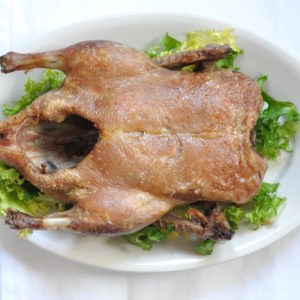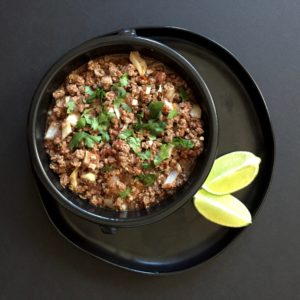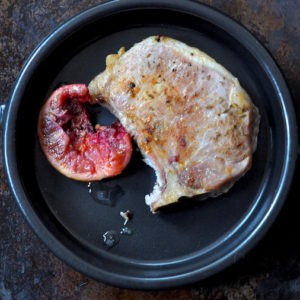Rick Bayless’s Tomatillo Braised Pork Loin
No one understands and appreciates the American Dream of hard work leading to material rewards better than a non-American. The Ecuadorian, Mexican, Dominican, and Salvadorian cooks I’ve worked with over the years make most CIA-educated white boys look like clumsy, sniveling little punks.
Anthony Bourdain, Kitchen Confidential
Dishwashers are God’s gift to the restaurant business.
Danny Ahern explaining Hortensia to Shauna, Gluten Free Girl And The Chef
The “Latins” are in every New York kitchen. They bring food to your table and clean up the plates afterwards. They make most of the food…while the elite positions, on the line, are reserved for the white guys…To most people, they were invisible–even to their employers (they are “Latins” like a race, rather than Mexicans, Uruguayans, or Peruvians), a pool of interchangeable laborers…piled into one-bedroom apartments that no one wants to know about.
Bill Buford, Heat
We will build a great wall along the southern border.
And Mexico will pay for the wall.
Donald Trump, July 2016
—

Tomatillo Braised Pork Loin comes from Corby Kummer’s lovely The Pleasures Of Slow Food, who in turn takes the recipe from Rick Bayless’s Mexico, One Plate At A Time.

I had not made tomatillo braised pork loin in years. Once I began, I remembered why: this is a demanding recipe. You are asked to brown pork, the blacken vegetables beneath the broiler, puree said veggies in a food processor, then combine meat and sauce in the braise. Somewhere in there, you’re prepping potatoes. It’s a lot of work. It’s a lot of dishes.
 Fortunately, the payoffs are high: tomatillo braised pork is hard to stop eating, a flamingly spicy dish that only improves if allowed to rest overnight. And as you weep into your plate, you can tell yourself its the peppers, not the realization that your countrymen are racist, homophobic, anti-Semites. (February 2019: And we thought it was bad then.)
Fortunately, the payoffs are high: tomatillo braised pork is hard to stop eating, a flamingly spicy dish that only improves if allowed to rest overnight. And as you weep into your plate, you can tell yourself its the peppers, not the realization that your countrymen are racist, homophobic, anti-Semites. (February 2019: And we thought it was bad then.)

Tomatillo Braised Pork Loin
Serves 2-3. To increase serving size, increase amount of pork
From Corby Kummer’s The Pleasures Of Slow Food, who in turn took the recipe from Rick Bayless’s Mexico, One Plate At A Time
For the pork:
2-4 tablespoons canola oil (amount depends on pot size)
1 1/2 to 2 pounds best quality boneless pork loin (see notes)
For the tomatillo sauce:
1 pound tomatillos, husked and rinsed (see notes)
2 jalapeño or serrano chiles (I used two serranos)
1 white onion, peeled and sliced
3 large garlic cloves, peeled and minced
1 1/2 cups water
1/3 cup cilantro leaves, finely chopped
1 teaspoon fine sea or table salt
10 small red boiling potatoes, halved or quartered, depending on size
Preheat the oven to 325F
Notes before beginning:
Read the recipe through before beginning to cook. Have ingredients prepped: sliced, peeled, chopped, etc. You will need either a blender or food processor to make the tomatillo sauce.
Bayless calls for parboiling the potatoes separately, then adding them to the pork during the final 10 minutes of cooking. You can do this, or slice them into small pieces and cook them alongside the pork. I’ve done both, but ensuring the potatoes are cooked through can be tricky with boneless loin, which cooks rapidly. You can also simply cook potatoes separately, as I did here, adding them to the final dish.
The size of your pork loin determines cooking time. Boneless loin is best here, though I have made this with bone-in roasts. The pork loin here was long, skinny, boneless, and lean. It needed only 30 minutes at 325F.
Pork is safely cooked at 145 F. If your pork is organic, a faintly pink middle is safe. Bear in mind meat continues cooking after being removed from the oven. If your pork is not organic, ensure it is cooked through.
Take care when handling hot peppers. Wash hands in warm soapy water before touching your eyes or other sensitive spots. Contact lens wearers, be careful!
The recipe:
Make the tomatillo sauce:
Place the tomatillos and peppers on a baking sheet. Broil, turning vegetables with tongs so each “face” becomes blackened. Remove tray from oven. While the tomatillos and peppers cool,
Brown the pork:
If, like me, you have a loin that is too long to fit your pan, slice it in half.
This recipe calls for browning the pork, then adding it to a braising pan that goes into the oven. I prefer to brown meats in a 12-inch sauté pan, then braise in a 4-quart Staub “everyday pan.” The Staub requires gentle preheating, which I’ve integrated into the recipe.
Using either a 4-quart lidded enameled cast iron pot, lidded casserole, or frying pan, pour a tablespoon of canola oil into the pot and set the burner to medium high. Add the pork, allowing each “face” to brown. This will take 3-5 minutes per side, depending on the cut you’ve purchased and your patience.
Once the pork is browned, set it aside while you finish the tomatillo sauce.
Return to the tomatillos and peppers, which should be cool enough to handle. Place them in a food processor or blender. Pulse until blended. If you used a processor, remove the blade, wash it, and set the work bowl aside.
If you browned the pork in a frying pan, you’ll need a braising vessel, ideally lidded and 3-4 quarts, as noted above. Place the braising vessel on the stove, adding the remaining canola oil. There should be enough to coat the pan bottom generously. Turn the heat the medium. Add onions and cook, stirring, 5-7 minutes, until soft and golden. Do not allow to fry a deep brown.
Add garlic and cook another minute.
Increase heat to medium-high. When onion/garlic mixture begins sizzling–this should happen quickly–pour in tomatillo puree. Allow to cook down a few minutes, stirring continually. It will thicken and darken.
Add water, cilantro, and salt. Stir to combine.
Set pork atop the sauce. Cover with lid or foil. Place in oven.
To make the potatoes:
While pork is cooking, set a pot of heavily salted water to boil.
Scrub potatoes and either halve or quarter, depending on size. Add when water is boiling.
Cook potatoes until tender; you can either add them to pork during final ten minutes of cooking or cook them in the boiling water, I did, plating them with the pork at serving time.
Check pork after 30 minutes; cooking time, as noted, depends on size and cut. Pork is done at 145 degrees F, or lacking a thermometer, when meat has barest trace of pink in the middle. It will feel firm. If pork is not cooked, return to oven for another 15 minutes, testing again for doneness. Pork loin tends to be lean, so avoid overcooking.
To serve: allow pork to rest 10-20 minutes beneath a foil tent. Spoon tomatillo sauce over a warmed platter (okay, ideally a warmed platter) add the pork loin, sliced if your wish. Nestle the potatoes alongside the meat.
This is a meal in itself, needing no further accompaniment, but a pile of fresh tortillas never goes amiss.
Leftovers, should you have any, keep refrigerated for three days. Potatoes do not freeze well. Tomatillo sauce can be frozen, but the texture suffers; straining the onion out helps. The pork itself freezes well provided it is well-wrapped.
If you are binge eating from stress or sorrow, know that leftover tomatillo sauce makes a wonderful dip for tortilla chips. Add sour cream and a freezing cold Corona and life will improve, albeit briefly.
Notes: My pork loin was too long to fit the pan, so I sliced it in two. I’ve also made this recipe with bone-in pork roasts; adjust the cooking time, as it will take far longer.
Fresh tomatillos are optimal for this recipe. If you can only find canned tomatillos, you’ll need 16 ounces. Add to recipe when tomatillo/pepper puree is poured into pan.





